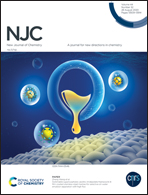Optimization of phthalazin-based aryl/heteroarylhydrazones to design new promising antileishmanicidal agents: synthesis and biological evaluation of 3-aryl-6-piperazin-1,2,4-triazolo[3,4-a]phthalazines†
Abstract
1-Monosubstituted and 1,4-substituted phthalazins based on aryl/heteroarylhydrazinyl have demonstrated attractive antileishmanial profiles against amastigote forms of the Leishmania braziliensis parasite. Further optimization of the mentioned acyclic scaffold motivated us to design a series of 3-aryl-1,2,4-triazolo[3,4-a]phthalazines, cyclic versions of the phthalazins based on aryl/heteroarylhydrazinyl, which have not been evaluated against Leishmania parasites yet. In order to compare to phthalazine-based aryl/heteroarylhydrazones, five essential 3-aryl-6-piperazin-1,2,4-triazolo[3,4-a]phthalazines were efficiently prepared in excellent yields (73–83%) through a facile one-pot procedure from 4-chloro-1-phthalazinyl-arylhydrazones via C–H dehydrogenative cyclization using silver(I) salt. From in vitro antileismanial evaluation, compound 2d, a nitro derivative, was identified as the most promising agent with a good anti-amastigote response (IC50 = 9.37 μM) and low relative toxicity against peritoneal macrophages (LD50 = 123.93 μM). A moderate response was found against clinical amastigote isolates of L. braziliensis, although superior compared to the reference glucantime. A comparison with their phthalazin analogues based on aryl/heteroarylhydrazinyl gave evidence that the efficacy of each chemical system is determined by the nature of the functionalization next to the aryl moiety, which suggests that different mechanisms of action are involved for each chemical system. The cyclized form led to an enhancement of the antileismanial activity compared to the acyclic form, but the nitroderivatives seemed to be highly more toxic than the parent non-cyclized compounds. From the three compared phthalazine groups, 4-chloro-1-phthalazine-(5-nitrofuryl)hydrazinil with a nanomolar antileishmanial response was identified as a promising lead for further optimization, whereas compound 2d emerges as a prominent hit platform to prepare a group of derivatives based on phthalazine-1,2,4-triazolo bearing 3-nitro-phenyl at the 3-position.
![Graphical abstract: Optimization of phthalazin-based aryl/heteroarylhydrazones to design new promising antileishmanicidal agents: synthesis and biological evaluation of 3-aryl-6-piperazin-1,2,4-triazolo[3,4-a]phthalazines](/en/Image/Get?imageInfo.ImageType=GA&imageInfo.ImageIdentifier.ManuscriptID=D0NJ01206H&imageInfo.ImageIdentifier.Year=2020)


 Please wait while we load your content...
Please wait while we load your content...